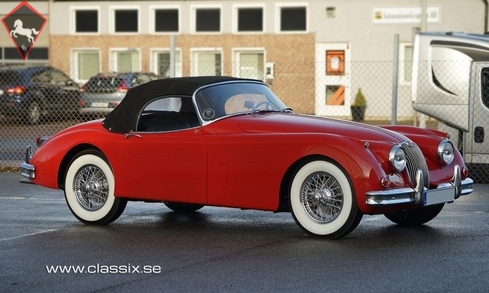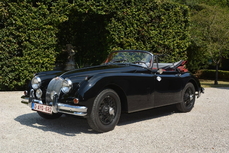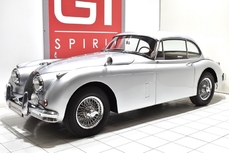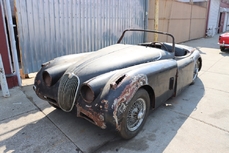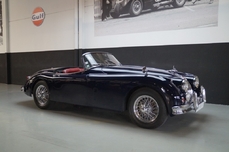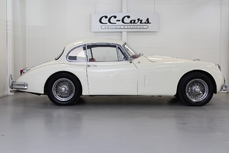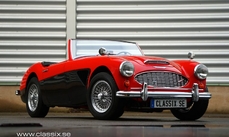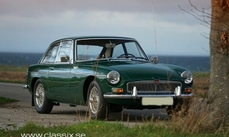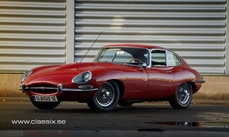Jaguar XK150 Jaguar XK 150S Convertible from 1958
General description :
The Jaguar XK models started with the XK 120 already back in 1948. In 1954, they made the car a little bit faster, so the name changed to XK 140 even though it was not capable of 140 mph. The last car in the Jaguar XK era was the XK 150 that came around 1957. There were a couple of different versions available of the XK 150 over the years. XK 150 3.4 with double SU 190hp XK 150 3.4 S.E with double SU 210hp XK 150 3.4 S with triple SU and 250hp. In 1959, a 3.8l version was introduced giving the XK 15hp more.
Exterior: The restoration work on this car started from a very good base with minor rust. The Jaguar XK 150 S is today in the very same Carmen red as it was when it left the factory in September 1958. The now-10-year-old paintwork is stunning and it really pops with those white wall tyres. All of the chrome is new and the same for all rubber details. The gaps are excellent and all panels close properly. The new black soft top has a very nice stretch to it. The chromed wire wheels are also new. This highly desirable Jaguar XK 150 S looks absolutely striking driving down the road.
Interior: Inside the Jaguar XK 150S OTS, you have a new leather interior in top quality. New carpets and refurbished wood panels. Underneath the carpets, you have Dynamat to give you back that solid feel when you drive the car. The instruments have been rebuilt by a specialist here in Sweden, Jige Instruments. The new mohair soft top has a very good stretch and this classic actually looks good even with the roof up.
Jaguar XK 150S
Engine: Well, since everything else on this car is new, I am sure you understand that also the engine had a complete rebuild. Starting with a new clutch and release bearing, resurfaced flywheel. The engine from the bottom up with new bearings, weighed and balanced pistons and rods. Resurfaced head and grinded valve seats. New valve seals. All gaskets replaced and going out with style in a new exhaust. New chains and tensioners. Carburettors rebuilt and a complete new wiring loom fitted. All bushings in the front and rear. Rebuilt wiper motor and all other electrical equipment has been looked over. Rebuilt radiator and everything in the brake system is new. Just like the rebuilt gearbox and overdrive. Many of the parts for this car were ordered from Jaguar XK 150S specialist Guy Broad in U.K .
History: The 1958 Jaguar XK 150S Open two-seater was completed on the 18th of August in 1958. It is today in the birth colours, Carmen red with black leather interior. It has the original engine, gearbox and body. The original distributor was Jaguar Cars New York USA and the first owner was Mrs A.H Howe. The Jaguar’s original red handbook is still with the car, and so are the other original items. The XK 150S came to Sweden in 2014, but the car was first registered here when the restoration was completed in August 2020. This Jaguar XK 150S OTS had one owner here in Sweden. The entire restoration is supported with invoices and pictures.
Make:Jaguar
Model:XK150 S OTS
Km:30
Transmission:4 speed+overdrive
Manufactured in:U.K
Horsepower/kw:250
Condition:1
https://www.classix.se/classic-cars/jaguar-xk-150s-ots-1958/
1958 Jaguar XK150 Jaguar XK 150S Convertible from is listed sold on ClassicDigest in Saxtorp by Auto Dealer for €138000.
Car Facts
Car type : Car Make : Jaguar Model : XK150 Model Version : Jaguar XK 150S Convertible from Engine size : 0.0 Model Year : 1958 Sub type : Convertible Location : Saxtorp
Sold
Seller Information
Sold
People who viewed this Jaguar XK150 also viewed similar Jaguar listed at ClassicDigest
Other cars listed for sale by this dealer
About Jaguar
Ah, the story of Jaguar, from its early days as the SS Cars Ltd. to its pinnacle with the D-type, and the street-going evolution in the form of the iconic E-type. There's something quintessentially British about this tale, and I'll narrate it as a British journalist might.In the Beginnings:
Our journey into the world of Jaguar begins in the 1930s, when a company known as SS Cars Ltd. emerged. Despite the unfortunate coincidence of their initials with the rising political tensions in Europe, they started producing stylish and performance-oriented cars. The SS 100, introduced in 1936, was a symbol of elegance and speed, setting the stage for what would become Jaguar.
The Birth of Jaguar:
As the shadows of World War II loomed, SS Cars Ltd. wisely decided to disassociate themselves from the SS initials. Thus, in 1945, they officially became Jaguar Cars Ltd., a name that would soon be synonymous with British luxury and performance.
The XK Series:
Jaguar's post-war era brought us the XK 120, a true sensation in 1948. With its sleek design and a powerful 3.4-liter inline-six engine, it became the world's fastest production car. The XK 120 was the blueprint for what lay ahead – Jaguars that blended style with speed in a uniquely British fashion.
The D-type Dominance:
Then came the D-type, a true racing legend. Introduced in 1954, it won Le Mans three times in the 1950s, showcasing Jaguar's engineering prowess. With its innovative monocoque construction and the iconic fin at the back, the D-type was the apex of Jaguar's motorsport success.
The E-type Emergence:
But the true turning point arrived in 1961 with the introduction of the E-type, often described by Enzo Ferrari as "the most beautiful car ever made." Its long bonnet, curvaceous body, and a 3.8-liter engine delivering exhilarating performance made it an instant classic. The E-type was not just a car; it was a work of art on wheels, and it could hit 150 mph on the road.
Street and Racing Success:
The E-type's beauty was matched by its capability on the track. The lightweight E-types were particularly successful in various racing events, cementing Jaguar's reputation as a force to be reckoned with in motorsport.
The Age of Refinement:
As we delve deeper into the Jaguar story, we find that the 1950s and 1960s were an age of refinement and expansion. Alongside the magnificent D-type and the E-type's iconic emergence, Jaguar introduced models that further solidified its reputation for luxury and performance.
The MK2:
In the late 1950s, Jaguar unveiled the MK2, a sports sedan that combined elegance with power. This sleek four-door saloon was a favorite of bank robbers and law enforcement alike, thanks to its exceptional speed and handling. The MK2 was a symbol of Jaguar's ability to blend sophistication with performance and had a successful racing career as well.
The XJ6:
Fast forward to 1968, and Jaguar launched a car that would define luxury saloons for decades to come – the XJ6. It was a masterpiece of engineering and design, featuring a smooth inline-six engine, independent rear suspension, and a spacious, beautifully appointed interior. The XJ6 was a symbol of British elegance and provided a ride so smooth that it seemed to glide over the road. It became the flagship model for Jaguar and set the standard for luxury saloons, showcasing a level of refinement that left competitors in awe.
The Blend of Classic and Modern:
While the MK2 and XJ6 represented the evolution of Jaguar's saloon cars, they maintained the brand's commitment to performance and luxury. These cars didn't just belong on the racetrack; they were equally at home cruising down the grand boulevards or gliding through the English countryside.
The Challenges of Change:
However, as the 1970s arrived, Jaguar, like many British automakers, faced financial challenges and changes in ownership. The British Leyland era brought both opportunities and struggles, as the brand navigated through various mergers and transitions.
Nevertheless, the legacy of the MK2 and XJ6, along with the D-type and E-type, continues to define Jaguar as a manufacturer that combines timeless elegance with a spirit of performance. These classic models, whether driven on winding roads or parked as collectors' treasures, serve as a testament to Jaguar's enduring presence in the world of automotive excellence.
The Jaguar story, from its early days as SS Cars Ltd. to the creation of automotive icons like the E-type, MK2, and XJ6, is a journey that reflects the very essence of British motoring – a blend of luxury, power, and style that continues to captivate enthusiasts and connoisseurs alike.
